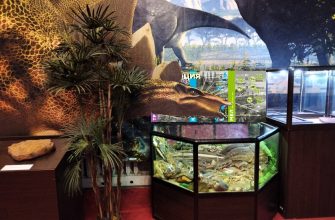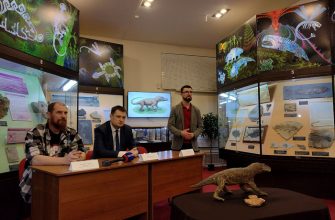A.U.Khlyupin
Running from north to south, the Vyatka river erodes the [west radical] bank near Kotelnich. This locality is comprised by rocks of Tatarian Stage of the Upper Permian, on the boundary of the Mesozoic Era. The formation of the supercontinent Pangea had finished; the climate on the Earth was almost everywhere warm and dry, which gave numerous opportunities for the appearance of many new terrestrial forms of life.

At this time in history the Kotelnich locality was a large plain, stretching out hundreds of kilometres to the West territory the young Ural mountains, whose height could be compared with the modern Himalayas. Enormous streams with lots of fragmental rocks were directed towards a [vest] valley. Away from the mountain slopes the speed of the stream decreased. Bigger fragments (blocks of rock) fell out of the streams, followed by pebbles, sand, and at last clay with only a little sandy material, which was condensed into a thick rock termed marl. There were also seasonal climatic changes. Occasionally the inflow of sedimentary material became stronger, creating boggy, silty creeks. These formed natural traps for larger animals, like pareiasaurus. Death caught them suddenly, as unstable clays and silts held animals fast until, weakened in their attempts to become free from captivity, they were buried in the sediments.
Not all animals were immediately completely buried. Parts of big carcasses were on the surface for a time, evidenced by cracking and whitening of the bones. Carcasses also attracted small animals, which often perished near them. Exposed animals were eventually covered, becoming buried inside the sediments for many millions years.
During these years the animal’s bones were infilled by mineral compounds dissolved in the groundwater of the surrounding environment. Organic compounds are carried out of the structure of bones and are usually replaced by calcium carbonate (Ca CO3) in solution. In many cases the bones received no replacement and are entirely the original hydroxyapatite. In some cases, bones contain between 30-50% phosphate, and only partly replaced by calcite. This type of replacement creates the conditions necessary for the preservation of the smallest details of bone structure, and skin ossifications sometimes are saved. It helps to make very detailed scientific description of found species possible.

In most cases nearly complete skeletons of pareiasaurus are found at Kotelnich. Many look like they are standing on their limbs, with their pelvis and hind limbs set into the sediment deeper than the skull and fore limbs. Frequently, the skull is slightly lifted and the fore limbs are splayed apart, making it seem that the animal tried to shovel boggy silt while trying to get out from the natural trap. Hind limbs either are firmly placed beneath the body or stretched forward. The tail bends around either to the right or to the left. Such a position shows the animal was rapidly buried at the place of its death rather than being transported by water.
Sometimes near the skeletons of pareiasaurs isolated bones to complete skeletons are found, illustrating smaller representatives of the fauna. A complete skeleton of Suminia getmanovi was found under one pareiasaur during its removal from a grey-green coloured horizon with many clay pellets. Suminia’s skull was crushed by the lower jaw bones of the pareiasaur, and two broken fangs of the predatory reptile Gorgonopsia were next to them.
In other cases the skeletons of pareiasaurus are found with the spine bent to the right or to the left. The limbs are spread apart, and the front limbs are bent back and out or under the thorax.

One of the skeletons has a complete postcranial skeleton but the skull is represented by only fragments of jaws, which were on the top of the spine. Such a type of preservation suggests that the skull of the animal, lifted above the sediments had been destroyed by scavengers. A typical pareiasaur has a well preserved hind part of the skeleton but a front represented by sun whitened bones. In one specimen the animal’s skull was found in an over turned position, next to a lower jaw. In this case as in the previous the front part of the skeleton was eroded due to surface exposure.
The clay marl has a microstrata structure under practically every pareiasaur’s skeleton. Tracks of slowly flowing water are very clearly seen.
One more type of burial sees the animal’s whole skeleton over turned. Its a rare type of preservation at Kotelnich. As a rule skeletons found in such a position are highly degraded by modern erosive processes. Complete skeletons are especially rare because in most cases many bones, especially limbs, are displaced or absent. As in the previously cases, it seems to be connected with the duration an animal’s carcass spent on the surface, leading to its destruction by decomposition and scavenging.

An interesting discovery was made in 1999 when two pareiasaur skeletons were found in a structure resembling a rounded hole within the sediment. The top skeleton was buried in an over turned position and under it, on the bottom of the hole, there was a complete skeleton with sprawling limbs and a bowed vertebral column.
In 1998 near the village of Boroviki it a little pareiasaur was found lying on its back, with the limbs on one side missing and ribs were practically absent. It was found in grey-coloured clay marl with many isolated bones of small reptiles.
A skeleton of pareiasaur was found in 1994 near the village of Nizhnyaya Vodskaya. It was on its left side and the vertebral column was torn into numerous fragments, overlapping each other as if the skeleton was wrapped several times about a long axis. In this specimen there are practically no ribs or small bones (e.g. phalanxes, tail vertebrae).
Isolated bones of animals are often found, but skulls and limbs are only found occasionally. Variations in position shows that the burial of animals has proceeded in different ways. In some cases animals got trapped and rapidly sank. In other cases they perished on the surface, their carcasses were eaten by scavengers, and their bones whitened in the sun before they were covered by sediment. Other animals were carried by a stream, and they would accumulate in natural hollows. This is a reason for the large accumulation of bones of different animals buried in one place sometimes found at Kotelnich.

In one instance is it possible to speak about mass synchronous death of many animals. It was most likely caused by a rapid change in hydrological conditions in the territory. It is a bone bed of dicynodonts (Australobarbarus), which is usually found in one layer of a thickness about half a metre. The accumulation is especially large and very often upper jaw bones and other isolated bones are found near skulls. These remains form accumulations with bones from one or two other individuals. The position of skulls vary within wide limits and as a rule they caught on the ground by fangs. Bones of the postcranial skeleton were usually deposited elsewhere; however, in one case a dicynodont skeleton with limbs was found on its right side next to another skeleton buried in an over turned position with a bow-shaped vertebral column. And only in one case was the skeleton of a dicynodont found standing on its limbs, similar to its lifetime posture. Water movement was faster here than at the locality with the pareiasaur fauna. It is evidenced by numerous thin layers of sand interbedding with the clay marl, and a large number of limestone concretions and pellets.
A different type of burial is characteristic for big lens-like geological bodies such as Sokolya Gora (Rock) and Agafonovskaya Lens. A fauna of a different age is found there that is similar to the fauna of severo-dvinskaya by its look. In this case one commonly finds disarticulated bones in basal conglomerates bedded in the bottom of grey coloured sandstones lenses. Rarer, they are found in the stratified sandstones forming the lenses proper. The water in these river-beds moved much faster and animals endured a long period of posthumous transportation, leaving skeletons completely disarticulated and fragmented. Only isolated bones got into the floodplain sediment, and very occasionally completely skulls (e.g. Proburnetia vyatkensis). There may be skeletons of many individuals, a good example for it is a mass burial of reptiles on the Malaya Severnaya Dvina river.

Spore-pollen analysis shows that more then 30 species of plants grew in the Permian swamp. In the clay rocks of the locality there are no clear macrorests of plants, and it’s impossible to say anything about the root system’s imprints, except that it pierced horizons of bones-carrying deposits. However, in the contemporaneous paleoriver-bed of “Chizhevskaya lens” there are preserved not only completely carbonized and ferritic(?) trunks of ancient horsetail-like plants (Calamites), but also numerous leaves, reproductive organs and foetus of various fossil plants, and a complex of fresh water vertebrates, including fish scales. Among these fossils remains of Grossopterigien were found for the first time in sediments of this age on the territory of East Europe.
The modern geological sections of the 20 km long right bank of the Vyatka river under Kotelnich gives a good picture that sediment accumulation in Upper Permian epoch was very uneven. Rapid changes of environmental conditions were very frequent. Sometimes it led to desertification, preserving huge shallow river basins of deltaic type. The lower thickness of these redbeds have bone carrying horizons and the composition of the foundation is fine-grained orange sandstones.
In some scientists’ opinion (V. Tverdokhlebov, S.R.I. of Geology, Saratov University) the redbeds are aeolian in origin, in which skew stratification is typical for fossils. This hypothesis suggests that after the clay and silt deposition, which were brought from the east, the sands of the desert were blown in by dry, hot winds from the west, south-west. After the sand deposition, water again began to move and further clay sediments were deposited, but the fauna of vertebrates was greatly diminished. This fact is evidenced by only single bad preserved bones’ rests, found in upper red coloured layers. The exception is the mass accumulation of plant-eating dicynodonts, whose actual position in the section is disputable at this time.






